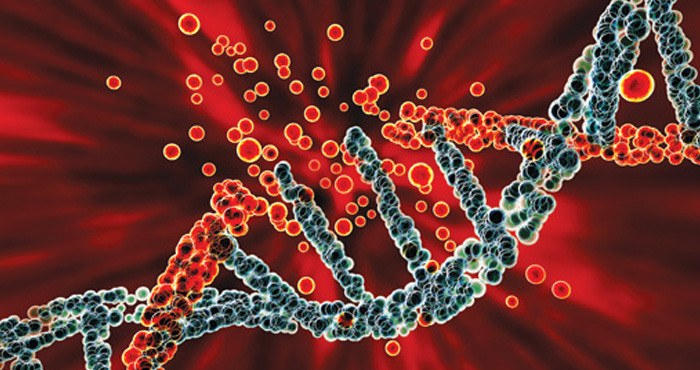The ageing process
In OTC
Follow this topic
Bookmark
Record learning outcomes
With estimates suggesting that one in seven of us will be over 75 years of age by 2040, attention is turning to the development of treatments to potentially target not only age-related diseases, but the actual ageing process itself

Learning objectives
After reading this feature you should be able to:
- Describe the role of genetics in ageing
- Explain efforts to develop anti-ageing treatments
- Understand the key steps pharmacies can take to support and safeguard the health of older customers.
A recent inquiry by the House of Lords Science and Technology Committee convened a panel of experts to examine the fundamental processes of ageing and look at how science and technology can enable healthy living into old age.1 The inquiry focuses specifically on the key factors that affect physical, cognitive and mental health as we get older.
In further testament to its increasing public health profile, ageing also featured as one of the Grand Challenges laid out in the previous Government’s industrial strategy policy paper.2 The stated aim was to ensure that people can enjoy at least five extra healthy independent years of life by 2035 by harnessing the power of innovation to help meet the needs of an ageing society. “We are living longer lives because of medical advances, better drugs, healthier lifestyles and safer workplaces,” the policy paper pointed out.
“A girl born in the UK today has a one in three chance of living to 100, and the chance of living to 100 will double in the next 50 years. Given this trend, it is time to radically rethink how we respond, at each stage in life, to the way that we support our families and communities, as well as the way that we approach work, finances, health and care, and housing.”
Biomarkers of ageing
One of the key areas the House of Lords inquiry is looking at is biomarkers and how these could be used to assess, measure and monitor the ageing process. Such biomarkers may encompass a wide range of indicators including blood or tissue markers, as well as measures of a person’s physical and cognitive performance.
Some important work has already been undertaken in the biomarker arena. For example, Medical Research Council guidelines on biomarkers3 of healthy ageing produced by an expert panel in 2012 identified important biomarkers covering five key ageing-related domains:
- Physical capability
- Cognitive function
- Physiological function
- Endocrine function
- Immune function.
Cardiovascular and lung health, glucose metabolism and musculoskeletal function were pinpointed as the most important biomarkers of ageing with respect to physiological function. These parameters are easily measurable with simple tests such as blood pressure and lipid levels, FEV1, fasting glucose and HbA1c – many of which can already be performed in the pharmacy setting.
Strength, locomotion, balance and dexterity emerged as key indicators of a person’s physical capability in ageing. Again, these biomarkers are relatively simple to assess with tests such as grip strength, standing balance and chair rising. Unsurprisingly, memory, processing speed and executive function were found to be important subdomains of cognitive function.
Endocrine and immune function were also shown to play an important role in driving underlying processes of ageing and could be directly measurable by biomarkers. Proposed biomarkers for endocrine function included HPA-axis markers, sex hormone levels (notably testosterone and oestrogen) and growth hormones, while inflammatory biomarkers such as IL-4 and TNF-alpha were identified as important barometers of immune system functioning with age.
Endocrine and immune function were also shown to play an important role in driving underlying processes of ageing
Genetics and DNA
As research into potential biomarkers of ageing continues to accelerate, one of the high profile candidates to emerge recently has been telomeres – DNA caps that seal the end of each DNA strand and which shorten progressively in length as we age.
“These cap-like structures represent but a fraction of our DNA, yet have a huge impact on the behaviour of our cells as a biological clock,” says the American Federation for Aging Research (AFAR).4 “Exciting investigations are now underway focused on telomeres as well as telomerase – the enzyme that replenishes telomeres in the cell. Telomerase is evolving into a new tool in clinical medicine and may hold the promise of engineering new life into old tissue.”
The role of telomeres and DNA in ageing raises its own questions about the underlying contribution of genetics. According to one of the major theories of ageing, it is the failure of cells’ intrinsic DNA repair mechanisms, and the resulting accumulation of uncorrected and damaged DNA, which acts as a major driver of human ageing.
Inherited differences in the genes that govern DNA repair may therefore explain why some people age more successfully than others. Large-scale genome-wide association studies have recently identified many loci that influence key human ageing traits, including lifespan.5 The role of certain genetic factors in modulating the ageing process is further evidenced by studies in centenarians, which suggest a degree of ‘inherited resistance’ to diseases that lead to early death.
The role of genetics in ageing remains highly complex and still incompletely understood – further complicated by the influence of epigenetic changes that are able to induce environmental and age-associated alterations in gene function itself.

Provocative issue
One of the most provocative issues being tackled by the House of Lords committee is the development of treatments to potentially target not only age-related diseases, but also the actual ageing process itself. However, before ageing can be effectively treated, we first need to understand the underlying biological processes that are at play.
There are several different overarching theories that strive to explain why ageing occurs. These include:
The cross-linking glycan hypothesis: As a person ages, proteins, DNA and other structural molecules within the body’s cells develop chemical bonds that ‘stick’ them together. These cross-links prevent unwanted proteins from being degraded and removed by enzymes, allowing them to build up within cells and cause damage.
The genome maintenance and oxidative damage/free radical hypothesis of ageing: According to these closely-linked theories, ageing results from the accumulation of DNA damage caused by oxidative free radicals or environmental factors such as radiation or toxin exposure, compounded by the decline in intrinsic DNA repair mechanisms over time. Mitochondria appear particularly susceptible to oxidative damage – and mitochondrial ageing is believed to be an important contributor to the overall ageing process.
The neuroendocrine hypothesis of ageing: This relates to the functional connections between the brain and endocrine system and the impact of changing hormone levels as we age. A particular area of current focus is the role of the insulin/insulin-like growth factor pathway in ageing.
The senescence theory
Today, the most widely accepted of all hypotheses on ageing is the evolutionary senescence theory. Cellular senescence, where somatic cells stop dividing, is synonymous with ageing and the accumulation of senescent cells in human tissues during the ageing process is a widely acknowledged to be the primary driver of age-related pathologies.
As a result, one of the most promising avenues being explored in anti-ageing drug development is senolytics – agents which target these senescent cells for removal. According to Professor Arne Akbar, an authority on the role of the immune system in ageing, a breakthrough in the senolytics space could occur as early as the next five to 12 years.6 However, if such treatments prove successful, it is easy to imagine the ensuing ethical furore and complex questions that would be raised.
Should ageing really be treated as a condition in and of itself? Who should receive anti-ageing treatments? When would they be used? Is it right for the NHS to finance intervention to prevent a ‘natural’ biological process?
Looking closer to home, existing drugs could also be repurposed for use as anti-ageing medications. These include metformin, which boasts pleotropic effects targeting multiple age-related pathways in the human body – most notably by reducing production of inflammatory markers that lead to cellular and DNA damage.
In human observational studies, metformin was found to decrease the risk of cardiovascular disease, cancer, depression and frailty. There is also early evidence for a positive effect on cognitive impairment. Several randomised clinical trials are ongoing which, if successful, may carve out a future role for metformin as a pharmacological intervention against both multimorbidity and ageing.7
Another existing drug being explored for its anti-ageing potential is the immunosuppressant rapamycin. Rapamycin acts on the mammalian target of the rapamycin (mTOR) pathway to limit DNA damage and mutations, with the effect of increasing lifespan. Research continues into whether or not this agent has the ability to actually slow down the ageing process itself.6
From a non-pharmacological perspective, there is compelling evidence from animal models to support the role of caloric restriction in slowing the ageing process. As AFAR explains: “Caloric restriction, in which laboratory animals are maintained on nutritionally balanced but sparse diets containing 30 to 40 per cent fewer calories than a normal diet, has been shown to reliably increase the average and maximum lifespans of a range of organisms, including worms, insects and rodents….By itself, caloric restriction retards almost all of the age-related changes mice normally undergo, including the onset of age-related diseases.”
This approach is currently undergoing more extensive evaluation in primate studies and may yet prove a simple but effective way for anyone to boost their longevity.
Inherited differences in the genes that govern DNA repair may explain why some people age more successfully than others
Loneliness in the elderly
One of the key ways in which pharmacy can help to improve the health of the ageing population in the UK is by recognising and responding to the often underestimated problem of loneliness. Currently there are 3.6 million older people in this country living alone, of whom more than 2 million are aged over 75 years. Loneliness imposes a heavy burden on older people, with its harmful health effects estimated to be equivalent to smoking 15 cigarettes a day.
Many older people describe feeling ‘invisible’ or ‘ignored’, so a friendly chat in the pharmacy, with staff taking the time to listen to and address older customers’ concerns, can be enough to make a difference. Age UK also provides a plethora of advice on helping to combat loneliness and older customers should be encouraged to explore the services offered, which include free weekly friendship calls. Volunteering or attending classes and groups through the University of the Third Age also provides important opportunities for older people to socialise and build friendships.

Key role for pharmacy
As an established source of support for elderly members of the community, local pharmacies have an important role to play in promoting healthy ageing.
Practical steps can help older customers to maintain their health and independence. These include keeping active with daily exercise, eating a healthy balanced diet, taking up the seasonal influenza vaccination and staying engaged with family and friends.
Current Government guidelines recommend that older adults undertake 150 minutes of moderate intensity activity per week, coupled with specific strengthening exercises twice a week. Between 15 to 20 minutes of exposure to natural sunlight is also recommended every day to boost vitamin D levels, deficiencies in which have been linked to cognitive impairment, bone problems and cardiovascular disease. As many people in the UK, particularly older individuals, are vitamin D deficient, a supplement may also prove beneficial – particularly during the darker winter months.
It is also important for older people to keep their fluid intake up as dehydration can lead to fatigue and confusion. Other important steps to safeguarding health in ageing include practising good foot care, undergoing regular hearing and sight tests, and establishing good sleeping patterns.
In terms of dietary advice for older customers, there is emerging evidence to suggest that adopting a Mediterranean diet may reduce the risk of frailty as people age.

Key facts
- By 2040, it is estimated that one in seven of the population will be aged over 75 years
- Senolytics represents an important avenue for future anti-ageing drug research
- Pharmacy has a pivotal role to play in helping older customers safeguard their health and independence as they age.
Pharmacotherapy
With increasing media focus on the ‘over medicalisation’ of the elderly, achieving the optimal risk:benefit balance in pharmacotherapy for older patients remains critical. Giving evidence to the House of Lords inquiry, Sir Munir Pirmohamed, professor of medicine and clinical pharmacology at Liverpool University, suggested that some older people are effectively being ‘poisoned’ by their current medications due to a lack of understanding of the action of these drugs in the older, comorbid phenotype.
This problem stems directly from the dearth of data in older patient populations with concomitant conditions who are typically excluded from clinical trials, noted the professor. Particular issues to contend with in older patients include optimal dosing, the implications of declining organ function and co-existing medical conditions and problems arising from polypharmacy and drug-drug interactions.
Pharmacists can help by carrying out regular medication reviews in older patients, particularly those with complex co-morbidities on multiple medications. It is also important to remain vigilant for potential drug interactions and adverse events (particularly when new medications are introduced) and to encourage patients to share any concerns about side-effects or untoward symptoms. Older individuals may also benefit from compliance aids, such as multi-compartment devices and medicine reminder charts, to help promote adherence to their prescribed regimens.
Bladder weakness
Urinary incontinence is common in both older men and women, with bladder weakness brand TENA estimating that 24 per cent of older people in the UK are affected.
This is due to changes in the body that occur as people get older, such as weakened pelvic floor muscles and loss of sensitivity in the nerves that control the bladder, says Lisa Myers, TENA training and brand manager.
Urinary incontinence can also be a symptom of certain long-term health conditions such as multiple sclerosis and Alzheimer’s disease. For elderly patients with dementia, it is wise to suggest they use incontinence pants rather than pads, she says. These will provide good security and odour protection, and require less changing for the patient or their carer.
Palliative and end-of-life care
As customers near the end of their life and long-term conditions enter the palliative stages of care, pharmacists still have an important part to play. The pharmacy is likely to be a frequent port of call for patients and family members of those with chronic but incurable conditions such as cancer.
Pharmacists can also take proactive steps to improve palliative and end-of-life care. This may include cutting back on the overall medication burden by tapering or discontinuing inappropriate or unnecessary drugs.
The 2019 Beers Criteria, which lists specific drugs and drug classes to be avoided or used with caution in older adults, provides a useful guide for effective and appropriate medication de-escalation. Pharmacists can also help to overcome administration challenges for patients no longer able to take medications orally by recommending alternative formulations such as topical gels or patches, suppositories or injections.
Adverse events such as gastrointestinal complaints, notably diarrhoea and constipation, and sedation can often prove problematic at end-of-life and may arise secondary to chronic conditions such as advanced cancer or as a direct result of medication toxicity.
Constipation is one of the commonest issues encountered in palliative care and one which pharmacists can assume an active role in managing. Ideally, the approach should focus on non-pharmacological advice as a first step including dietary changes (e.g. increasing fibre intake and adding wheat bran, linseeds or oats) and increased fluid intake, together with increased physical activity where possible.
References
- Lords Select Committee. Ageing: Science, Technology and Healthy Living – Lords Committee launches a new inquiry
- Policy paper. The Grand Challenge missions. Updated 13 September 2019
- Lara J et al. A proposed panel of biomarkers of healthy ageing. BMC Medicine 2015; 13(222)
- American Federation for Aging Research (AFAR)
- Melzer D et al. The genetics of human ageing. Nature Reviews Genetics 2019 doi:10.1038/s41576-019-0183-6
- British Society for Immunology (BSI) – Written evidence
- Valencia W et al. Metformin and ageing: improving ageing outcomes beyond glycaemic control. Diabetologia 2017; 60(9):1630-1638.
